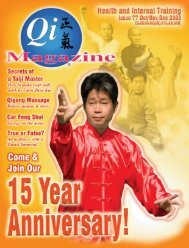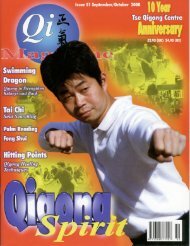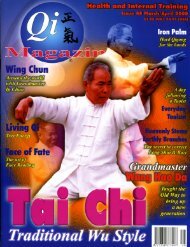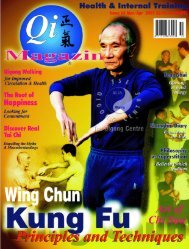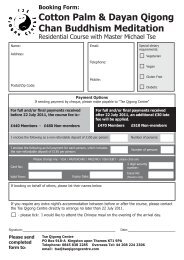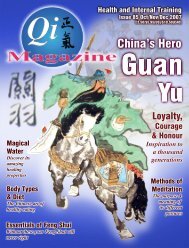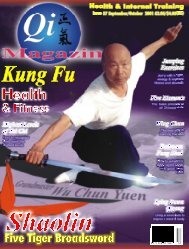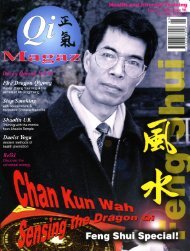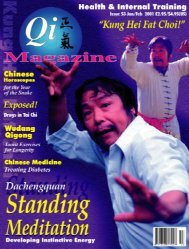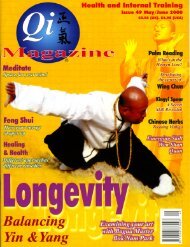You also want an ePaper? Increase the reach of your titles
YUMPU automatically turns print PDFs into web optimized ePapers that Google loves.
Whats in a Word<br />
For western people the Chinese language is very confusing. The sounds and tones are very<br />
difficult to say. For the written word, the situation is even more confusing. As you will know<br />
Chinese writing is made up of many different characters and so unless you know the character, it<br />
is impossible to guess what the word is or how to say it. For this reason, the Chinese language has<br />
a number of systems that make it more accessible to the western ear.<br />
When people say ‘Tai Chi’, they<br />
mean ‘Taiji’. ‘Taiji’ is the correct<br />
way of writing and pronouncing<br />
the word using Pinyin. If you listen to<br />
Chinese person speaking Mandarin they<br />
will pronounce the word more as “Tai gee”<br />
and so the Pinyin spelling of Taiji is more<br />
correct. The Cantonese is “Tai Gik”. So<br />
you see the spelling ‘Tai Chi’ is not very<br />
accurate.<br />
Pinyin means ‘phonetics’, and is<br />
the standard method for writing down<br />
Chinese using the Western alphabet. It is<br />
the only system used on Mainland China,<br />
and the Library of Congress has adopted<br />
it as the International standard. For this<br />
reason, Qi Magazine uses Pinyin.<br />
However it is a relatively recent<br />
system, so there are a lot of hangovers<br />
from the older systems still in used in the<br />
west. The most common of the old<br />
systems is the Wade system, created by an<br />
American. Wade is still used in Taiwan,<br />
(because the Taiwan government likes to<br />
exercise its independence from the<br />
Mainland).<br />
Wade sacrifices clarity for ease of<br />
use. Wade is easy for an English speaker<br />
to pronounce roughly, but using Wade it<br />
is impossible to know how it should be<br />
pronounced properly. Here are some<br />
examples:-<br />
separate word, so use the Wade<br />
translations above as examples.<br />
Next you need to know how to<br />
pronounce certain letters that you don’t<br />
see in English very much, such as ‘z’ and<br />
‘x’. Here are some tips so that at least you<br />
will be able to vocalise something.<br />
i - pronounced as “eee”<br />
j - pronounced as ‘gee’<br />
q - pronounced as ‘chee’<br />
c - pronounced as ‘sea’<br />
x - pronounced as ‘sss’<br />
s - pronounced as ‘tss’<br />
z - pronounced as ‘css’<br />
As you can imagine, it is<br />
impossible to capture the correct<br />
pronunciation without actually<br />
listening to the sounds.<br />
At first, the Wade system<br />
is much easier to follow,<br />
however the Pinyin system,<br />
once you have got use to it,<br />
more accurately captures<br />
the sounds and tones of<br />
Mandarin.<br />
Lastly, due to<br />
the number of<br />
Cantonese<br />
in the west, and thus the popularity of<br />
Cantonese martial arts, Qi Magazine uses<br />
some Cantonese terms when referring to<br />
the practice of Cantonese Martial arts. For<br />
example:<br />
Cantonese Pinyin Mandarin<br />
Wing Chun Kuen Yongchunquan<br />
Hung gar Hongjia<br />
Hei Gong <strong>Qigong</strong><br />
byDanielPoon<br />
Pinyin<br />
Qi<br />
<strong>Qigong</strong><br />
Gongfu<br />
Taijiquan<br />
Xingyiquan<br />
Baguazhang<br />
Yijing<br />
Wade<br />
Ch’i<br />
Ch’i Kung<br />
Kung fu<br />
T’ai Chi Ch’uan<br />
Hsing yi ch’uan<br />
Pa Kua Chang<br />
I Ching<br />
To be able to read a pinyin word,<br />
you need to know how to break it up into<br />
syllables. Wade places each syllable as a<br />
Qi Magazine 45



